Experimental Study of Condensation Heat Transfer and Pressure Drop inside a Small Diameter Microfin and Smooth Tube at Low Mass Flux Condition
Abstract
:1. Introduction
2. Experimental Apparatus and Procedure
3. Data Reduction
4. Experimental Results and Discussion
4.1. Frictional Pressure Drop Results and Discussion
Comparison with the Pressure Drop Correlations
4.2. Condensation Heat Transfer Coefficient Results and Discussion
Comparison with the Condensation Heat Transfer Correlations
5. Conclusions
Author Contributions
Funding
Acknowledgments
Conflicts of Interest
Nomenclature
| AD | average deviation, dimensionless |
| Bo | Bond number, dimensionless |
| Cc | coefficient of contraction, dimensionless |
| d | diameter [m] |
| G | mass flux [kg m−2s−1] |
| Ga | Galileo number, dimensionless |
| h | heat transfer coefficient [W m−2 K−1] |
| h” | saturated vapor enthalpy [kJ kg−1] |
| HB | heat balance, dimensionless |
| kl | liquid thermal conductivity [W m−2 K−1] |
| L | heat transfer length [m] |
| MD | mean deviation, dimensionless |
| n | number of fin, dimensionless |
| Nu | Nusselt number, dimensionless |
| P | pressure [Pa] |
| Ph | phase change number, dimensionless |
| Pr | Prandtl number, dimensionless |
| pressure drop [Pa] | |
| Q | heat exchange amount [W] |
| Re | Reynolds number, dimensionless |
| T | temperature [°C] |
| temperature difference between refrigerant and inner wall | |
| v | specific volume [m3 kg−1] |
| x | quality, dimensionless |
| Xtt | Lockhart-Martinelli parameter, dimensionless |
Greek Symbol
| α | heat transfer coefficient [W m−2 K−1] |
| β | area ratio, dimensionless |
| ξ | void fraction, dimensionless |
| δ | wall thickness [mm] |
| γ | apex angle [°] |
| θ | helix angle [°] |
| λc | thermal conductivity [W m−2 K−1] |
| ρ | density [kg m−3] |
| µ | viscosity [Pa s−1] |
| σ | surface tension [N m−1] |
| Φ | two-phase multiplier, dimensionless |
Subscripts
| a | adiabatic |
| c | coolant |
| e | equivalent |
| Exp | experimental |
| F | frictional |
| FC | forced convection |
| GC | gravity control convection condensation |
| h | hydraulic |
| i | inner |
| l | liquid |
| lo | liquid only |
| NC | natural convection |
| o | outer |
| Pre | prediction |
| R | refrigerant |
| Sat | saturation |
| v | vapor |
| vo | vapor only |
| tp | two-phase |
| wi | inner wall |
| wo | outer wall |
References
- Koyama, S.; Yonemoto, R. Experimental study on condensation of pure refrigerants in horizontal microfin tube-proposal of correlations for heat transfer coefficient and frictional pressure drop. In Proceedings of the International Refrigeration and Air Conditioning Conference, West Lafayette, IN, USA, 17–20 July 2006; pp. 1–8. [Google Scholar]
- Miyara, A.; Nonaka, K.; Taniguchi, M. Condensation heat transfer and flow pattern inside a herringbone-type micro-type tube. Int. J. Refrig. 2000, 23, 141–152. [Google Scholar] [CrossRef]
- Kim, N.H. Condensation heat transfer and pressure drop of R-410A in a 7.0 mm O.D microfin tube at low mass fluxes. Heat Mass Transf. 2016, 52, 2833–2847. [Google Scholar] [CrossRef]
- Kondou, C.; Mishima, F.; Liu, J.; Koyama, S. Condensation and evaporation of R134a, R1234ze(E) and R1234ze(Z) flow in horizontal microfin tubes at higher temperatures. In Proceedings of the International Refrigeration and Air Conditioning Conference, West Lafayette, IN, USA, 14–17 July 2014; pp. 1–8. [Google Scholar]
- Wu, Z.; Sunden, B.; Wang, L.; Li, W. Convective condensation inside horizontal smooth and microfin tubes. J. Heat Transf. 2014, 136, 051504. [Google Scholar] [CrossRef]
- Diani, A.; Cavallini, A.; Rossetto, L. R1234yf condensation inside a 3.4 mm ID horizontal microfin tube. Int. J. Refrig. 2017, 75, 178–189. [Google Scholar] [CrossRef]
- Hirose, M.; Ichinose, J.; Inoue, N. Development of the general correlation for condensation heat transfer and pressure drop inside horizontal 4 mm small-diameter smooth and microfin tubes. Int. J. Refrig. 2018, 90, 238–248. [Google Scholar] [CrossRef]
- Bashar, M.K.; Nakamura, K.; Kariya, K.; Miyara, A. Condensation heat transfer and pressure drop characteristics inside small diameter microfin tubes. In Proceedings of the Japan Society of Refrigeration and Air Conditioning Annual Conference, Koriyama, Japan, 4–7 September 2018; pp. 1–6. [Google Scholar]
- Rahman, M.M.; Kariya, K.; Miyara, A. Experimental investigation of condensation heat transfer and adiabatic pressure drop characteristics inside 2.13 mm ID microfin and smooth tube. Int. J. Air-Cond. Refrig. 2017, 25, 1750027. [Google Scholar] [CrossRef]
- Zhuang, X.R.; Chen, G.F.; Guo, H.; Song, Q.L.; Tang, Q.X.; Yang, Z.Q.; Zou, X.; Gong, M.Q. Experimental investigation on flow condensation of zeotropic mixture of methane/ethane in a horizontal smooth tube. Int. J. Refrig. 2018, 85, 120–134. [Google Scholar] [CrossRef]
- Fronk, B.M.; Garimella, S. Condensation of ammonia and high-temperature-glide ammonia/water zeotropic mixtures in minichannels—Part I: Measurements. Int. J. Heat Mass Transf. 2016, 101, 1343–1356. [Google Scholar] [CrossRef]
- Dorao, C.A.; Fernandino, M. Simple and general correlation for heat transfer during flow condensation inside plain pipes. Int. J. Heat Mass Transf. 2018, 122, 290–305. [Google Scholar] [CrossRef]
- Xiao, J.; Hrnjak, P. Heat transfer and pressure drop of condensation from superheated vapor to subcooled liquid. Int. J. Heat Mass Transf. 2016, 103, 1327–1334. [Google Scholar] [CrossRef]
- Ghim, G.; Lee, J. Condensation heat transfer of low GWP ORC working fluids in a horizontal smooth tube. Int. J. Heat Mass Transf. 2017, 104, 718–728. [Google Scholar] [CrossRef]
- Meyer, J.P.; Ewim, D.R.E. Heat transfer coefficients during the condensation of low mass fluxes in smooth horizontal tubes. Int. J. Multiph. Flow. 2018, 99, 485–499. [Google Scholar] [CrossRef]
- Shah, M.M. Improved correlation for heat transfer during condensation in conventional and mini/micro channels. Int. J. Refrig. 2018. [Google Scholar] [CrossRef]
- Lemmon, E.W.; Huber, M.L.; McLinden, M.O. Reference Fluid Thermodynamic and Transport Properties-REFPROP [9.1]; NIST Standard Reference Database; NIST: Gaithersburg, MD, USA, 2013. [Google Scholar]
- Collier, J.G.; Thome, J.R. Convective Boiling and Condensation, 3rd ed.; Oxford University Press: Oxford, UK, 1994. [Google Scholar]
- Smith, S.L. Void fractions in two-phase flow: A correlation based upon an equal velocity head model. Proc. Inst. Mech. Eng. 1969, 184, 647–664. [Google Scholar] [CrossRef]
- JCGM 100. Evaluation of Measurement Data-Guide to the Expression of Uncertainty in Measurement; JCGM: Sèvres, France, 2008. [Google Scholar]
- Revellin, R.; Thome, J.R. Adiabatic two-phase frictional pressure drops in microchannels. Exp. Therm. Fluid Sci. 2008, 31, 673–685. [Google Scholar] [CrossRef]
- Ichinose, Y.; Kudo, Y.; Bashar, M.K.; Kariya, K.; Miyara, A. Boiling and condensation heat transfer and pressure drop of grooved small copper tube. In Proceedings of the Japan Society of Mechanical Engineering, Saga, Japan, 19–22 September 2017; pp. 13–14. [Google Scholar]
- Yan, Y.Y.; Lin, T.F. Condensation heat transfer and pressure drop of refrigerant R-134a in a small pipe. Int. J. Heat Mass Transf. 1999, 42, 697–708. [Google Scholar] [CrossRef]
- Cavallini, A.; Censi, G.; Del Col, D.; Doretti, L.; Longo, G.A.; Rossetto, L. Experimental investigation on condensation heat transfer and pressure drop of new HFC refrigerants (R134a, R125, R32, R410A, R236ea) in a horizontal smooth tube. Int. J. Refrig. 2001, 24, 73–87. [Google Scholar] [CrossRef]
- Steinhagen, M.H.; Heck, K.A. Simple frictional pressure drop correlation for two-phase flow in pipes. Chem. Eng. Process. 1986, 20, 297–308. [Google Scholar] [CrossRef]
- Haraguchi, H.; Koyama, S.; Fujii, T. Condensation of refrigerants HCFC 22, HFC 134a and HCFC 123 in a horizontal smooth tube (1st report, proposals of empirical expression for the local frictional pressure drop). JSME Int. J. 1994, 60, 2111–2116. [Google Scholar]
- Olivier, J.A.; Liebenberg, L.; Kedzierski, M.A.; Meyer, J.P. Pressure drop during condensation inside horizontal smooth, helical microfin, and herringbone microfin tubes. J. Heat Transf. 2004, 126, 687–696. [Google Scholar] [CrossRef]
- Scott, D.S. Properties of co-current gas-liquid flow. Adv. Chem. Eng. 1964, 4, 199–276. [Google Scholar]
- Tandon, T.N.; Varma, H.K.; Gupta, G.P. A new flow regimes map for condensation inside horizontal tubes. Int. J. Heat Transf. 1982, 104, 763–768. [Google Scholar] [CrossRef]
- Wang, L.; Dang, C.; Hihara, E. Experimental study on condensation heat transfer and pressure drop of low GWP refrigerant HFO1234yf in a horizontal tube. Int. J. Refrig. 2012, 35, 1418–1429. [Google Scholar] [CrossRef]
- Son, C.H.; Lee, H.S. Condensation heat transfer characteristics of R-22, R-134a and R-410A in small diameter tubes. Heat Mass Transf. 2009, 45, 1153–1166. [Google Scholar] [CrossRef]
- Haraguchi, H.; Koyama, S.; Fujii, T. Condensation of refrigerants HCFC 22, HFC 134a and HCFC 123 in a horizontal smooth tube (2nd report, proposals of empirical expressions for the local heat transfer coefficient). JSME Int. J. 1994, 60, 245–252. [Google Scholar]
- Dobson, M.K.; Chato, J.C. Condensation in smooth horizontal tubes. J. Heat Transf. 1998, 120, 192–213. [Google Scholar] [CrossRef]
- Kedzierski, M.A.; Goncalves, J.M. Horizontal convective condensation of alternative refrigerants within a microfin tube. J. Enhanced Heat Transf. 1999, 6, 161–178. [Google Scholar] [CrossRef]
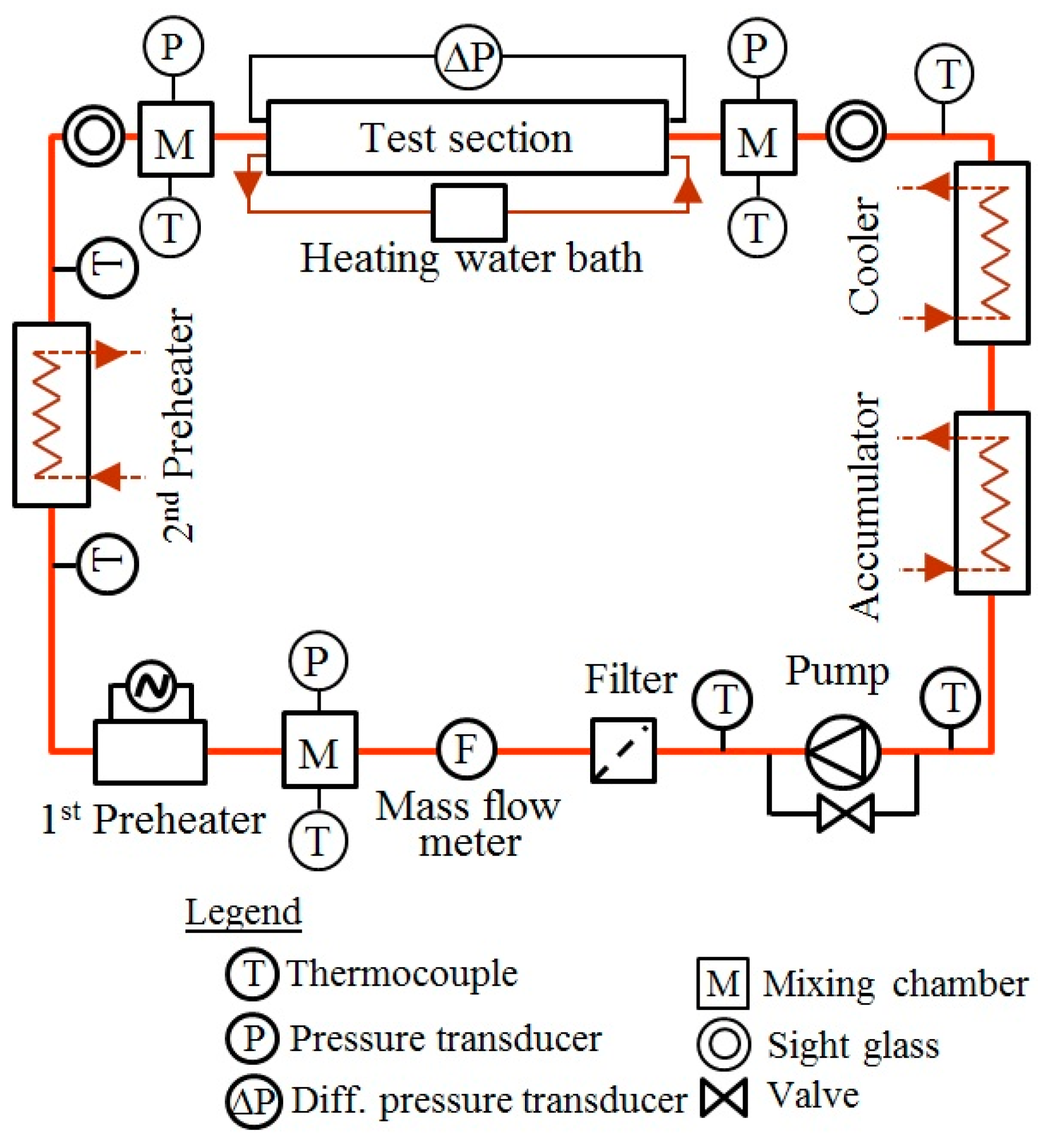


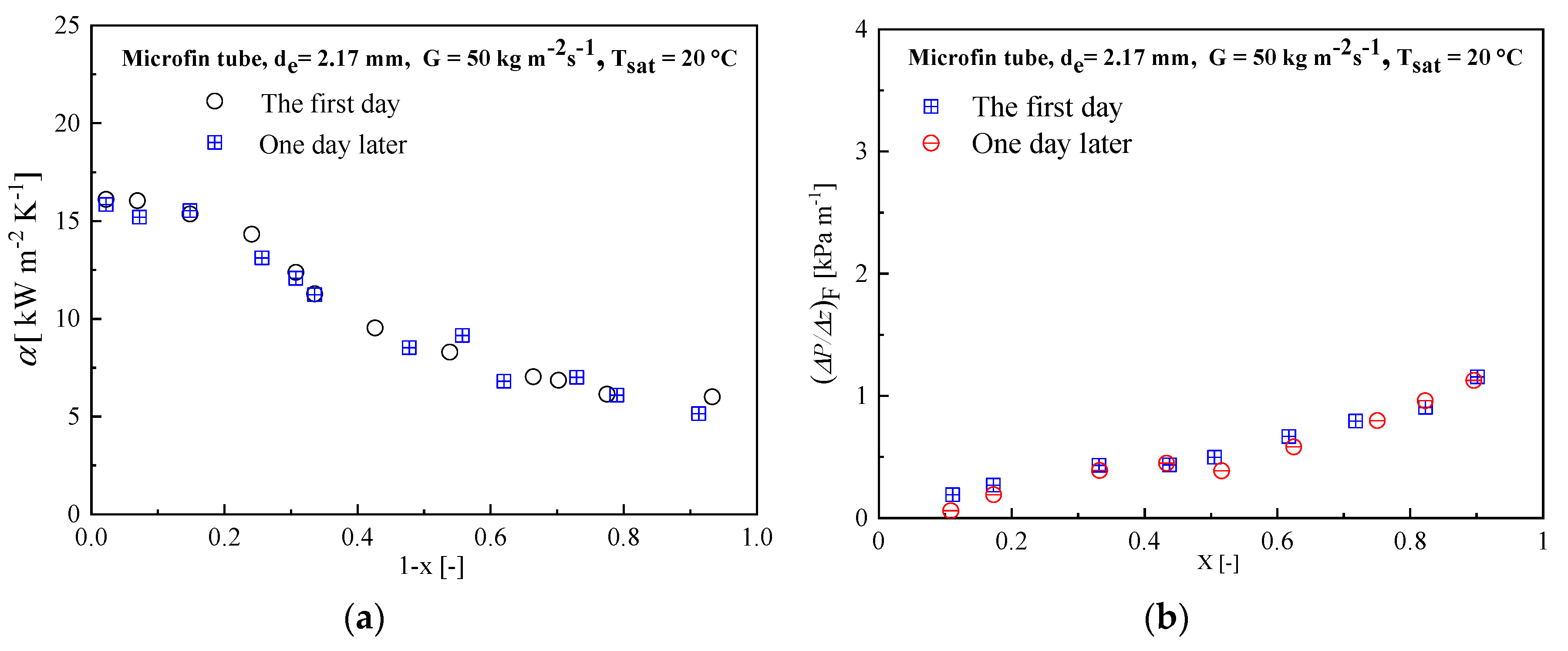
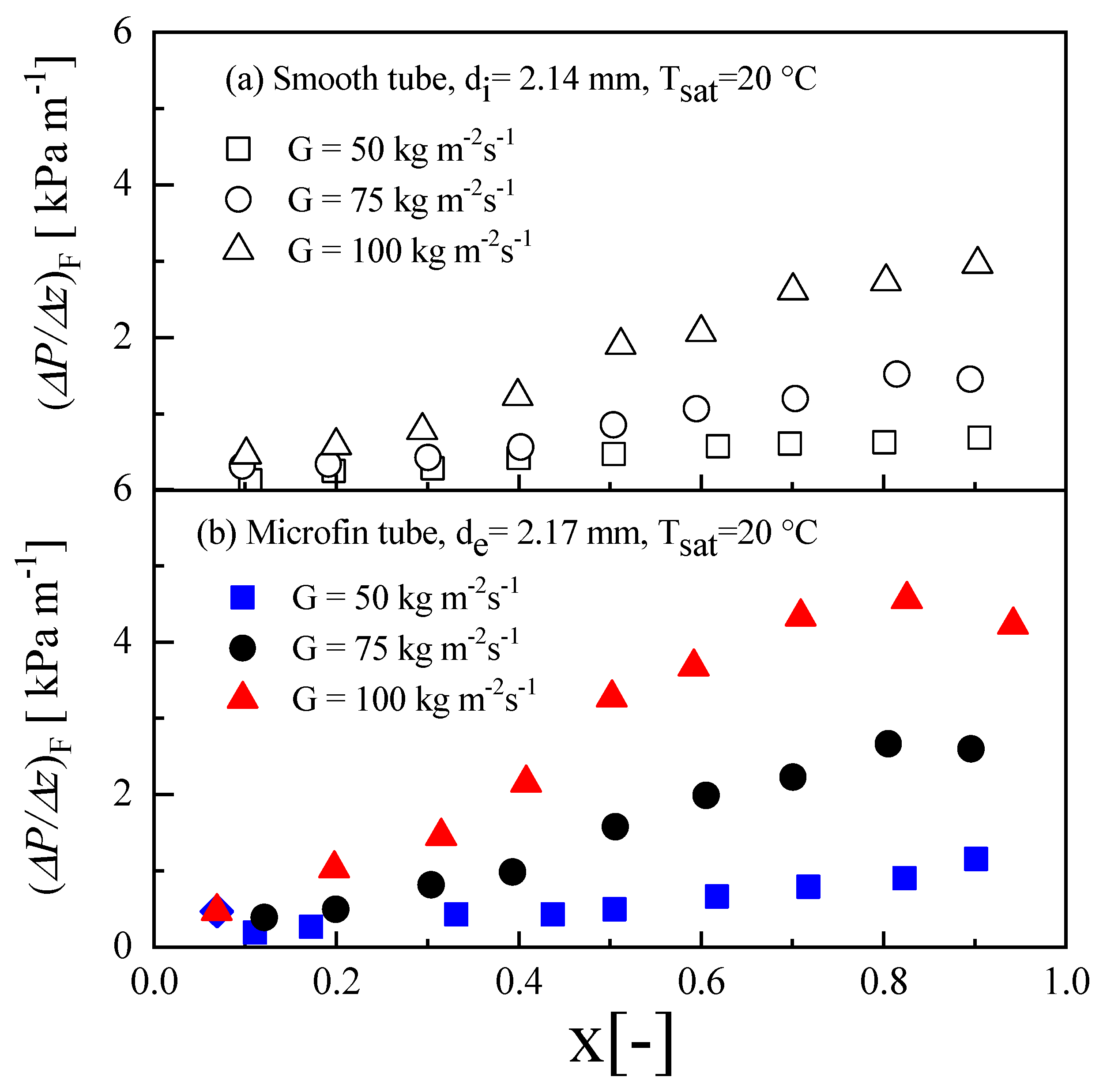
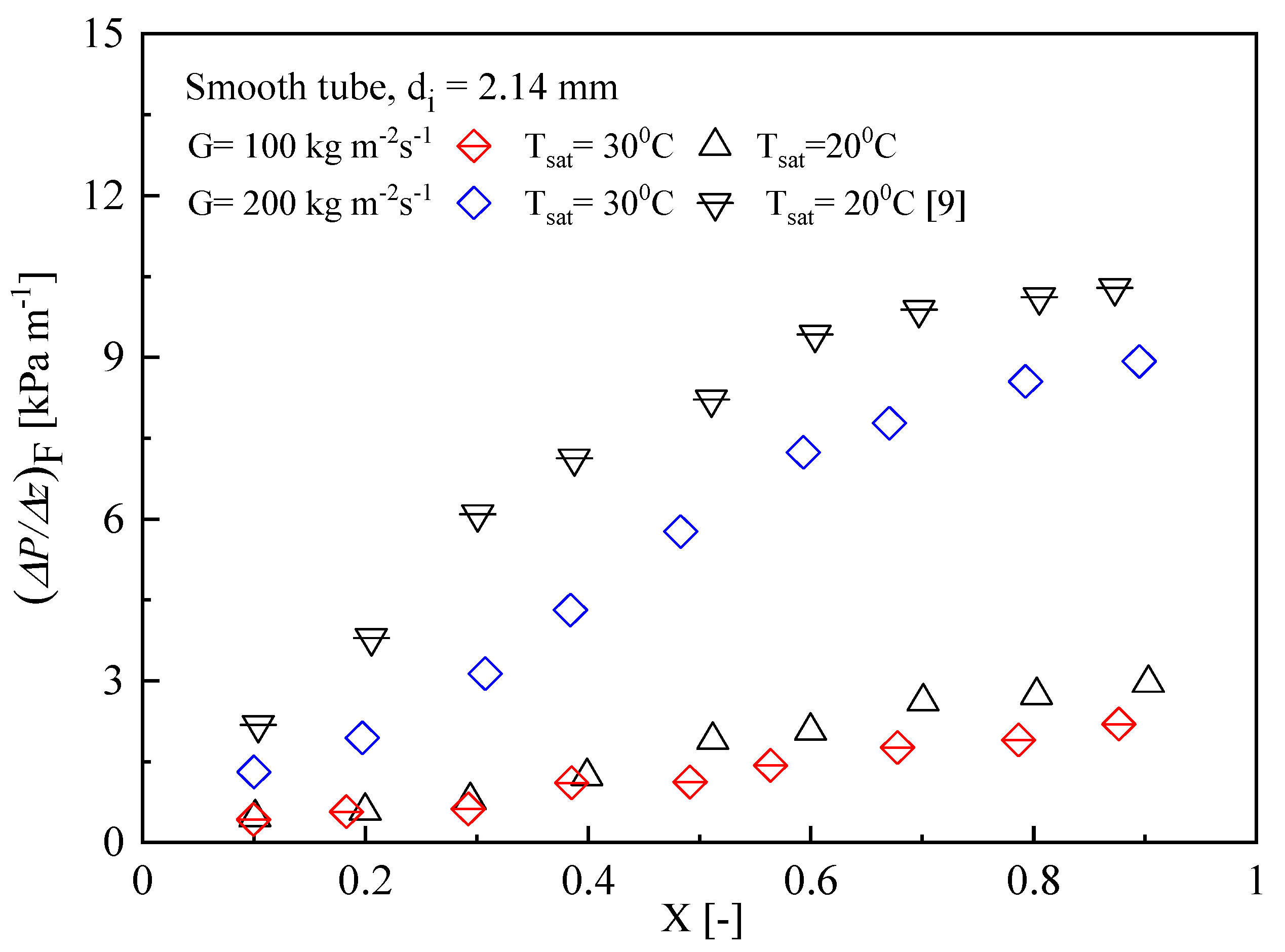
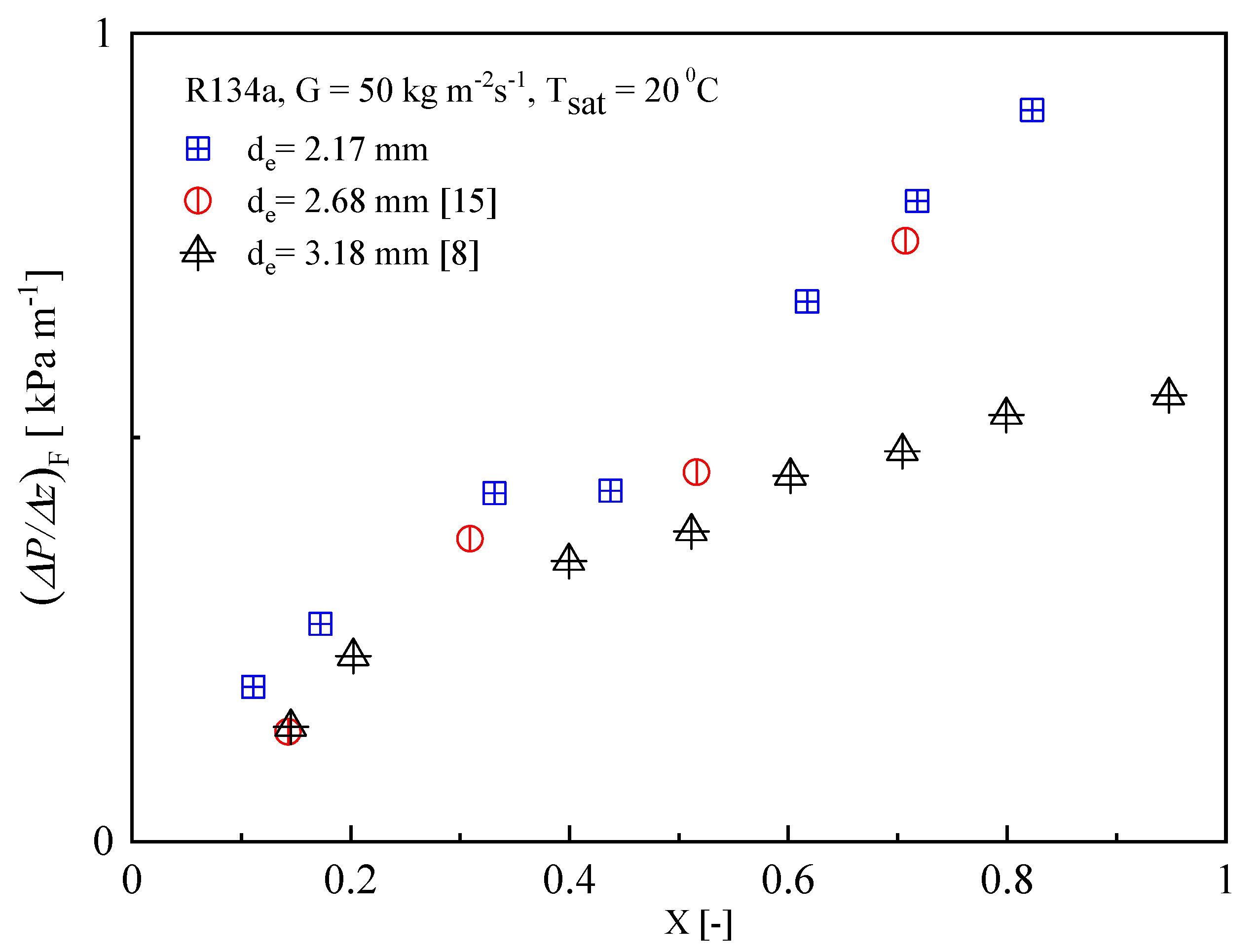

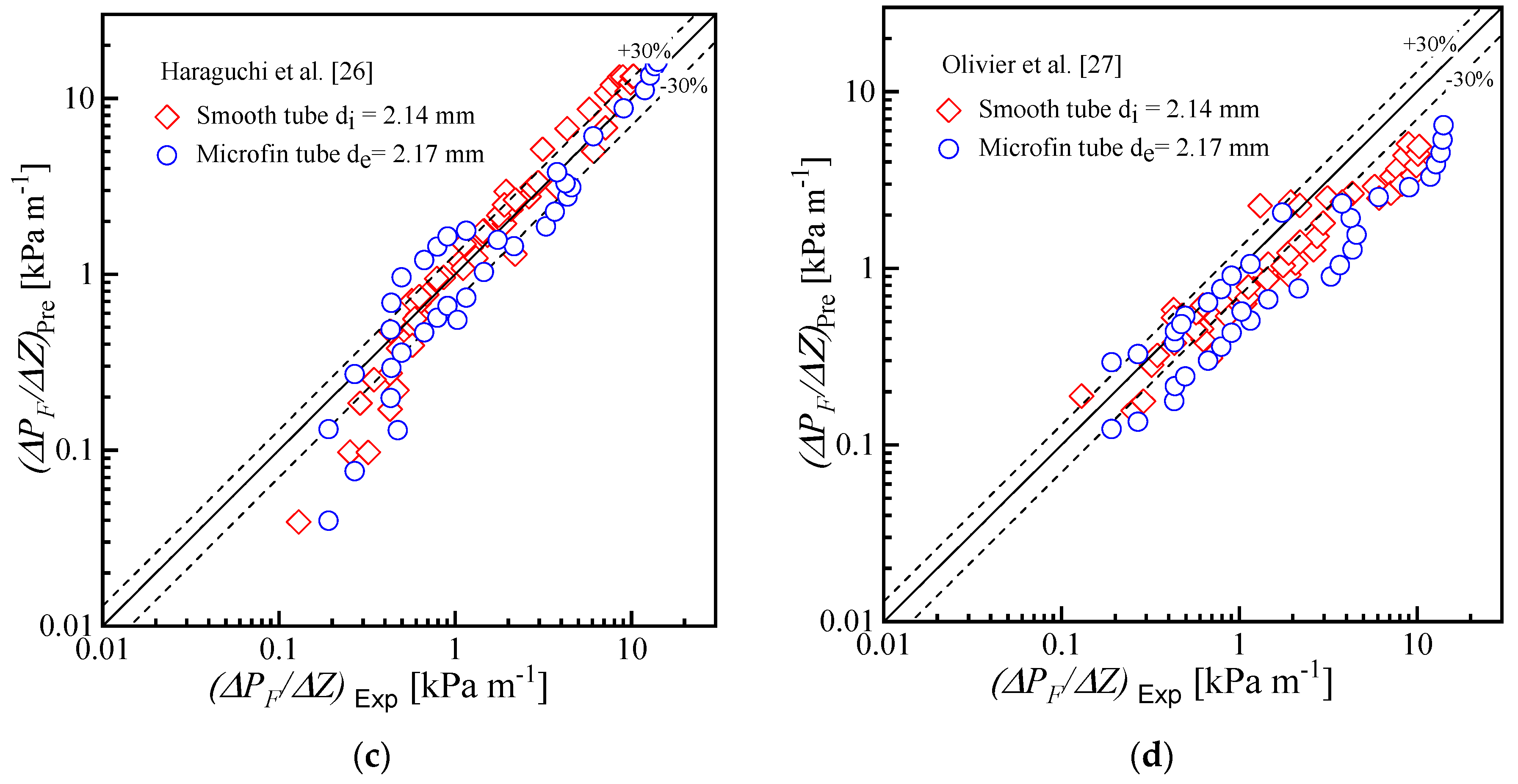
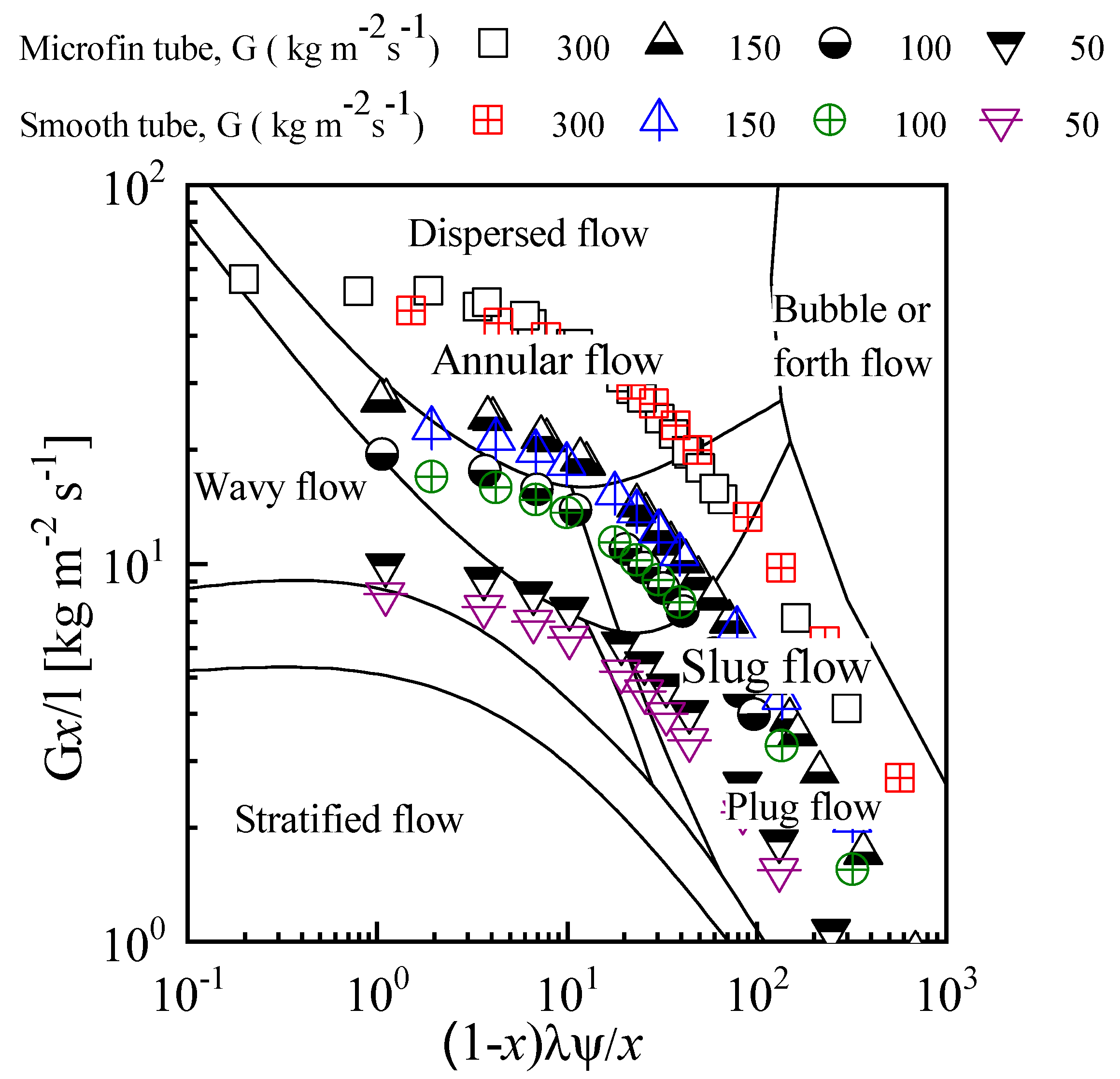
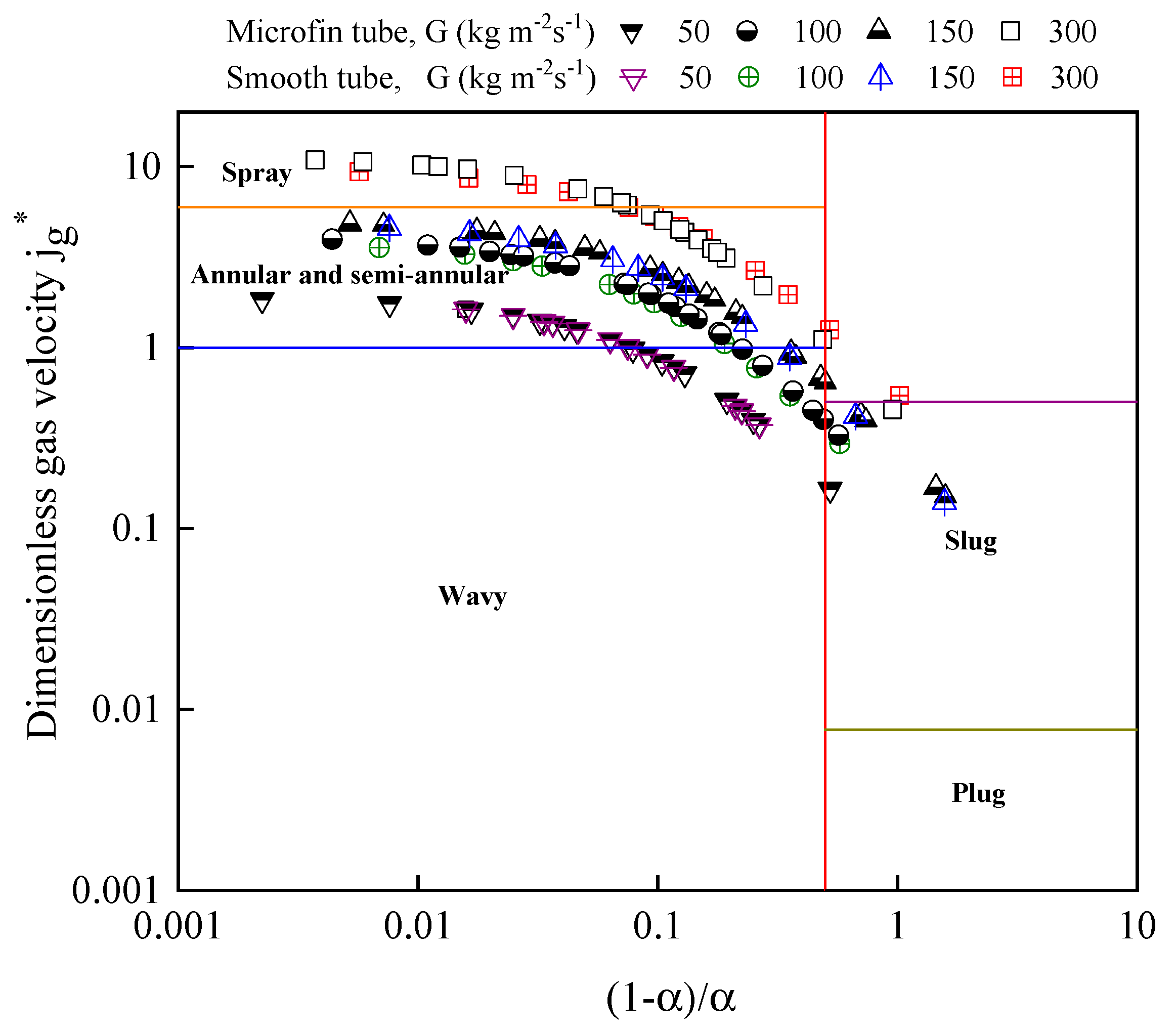
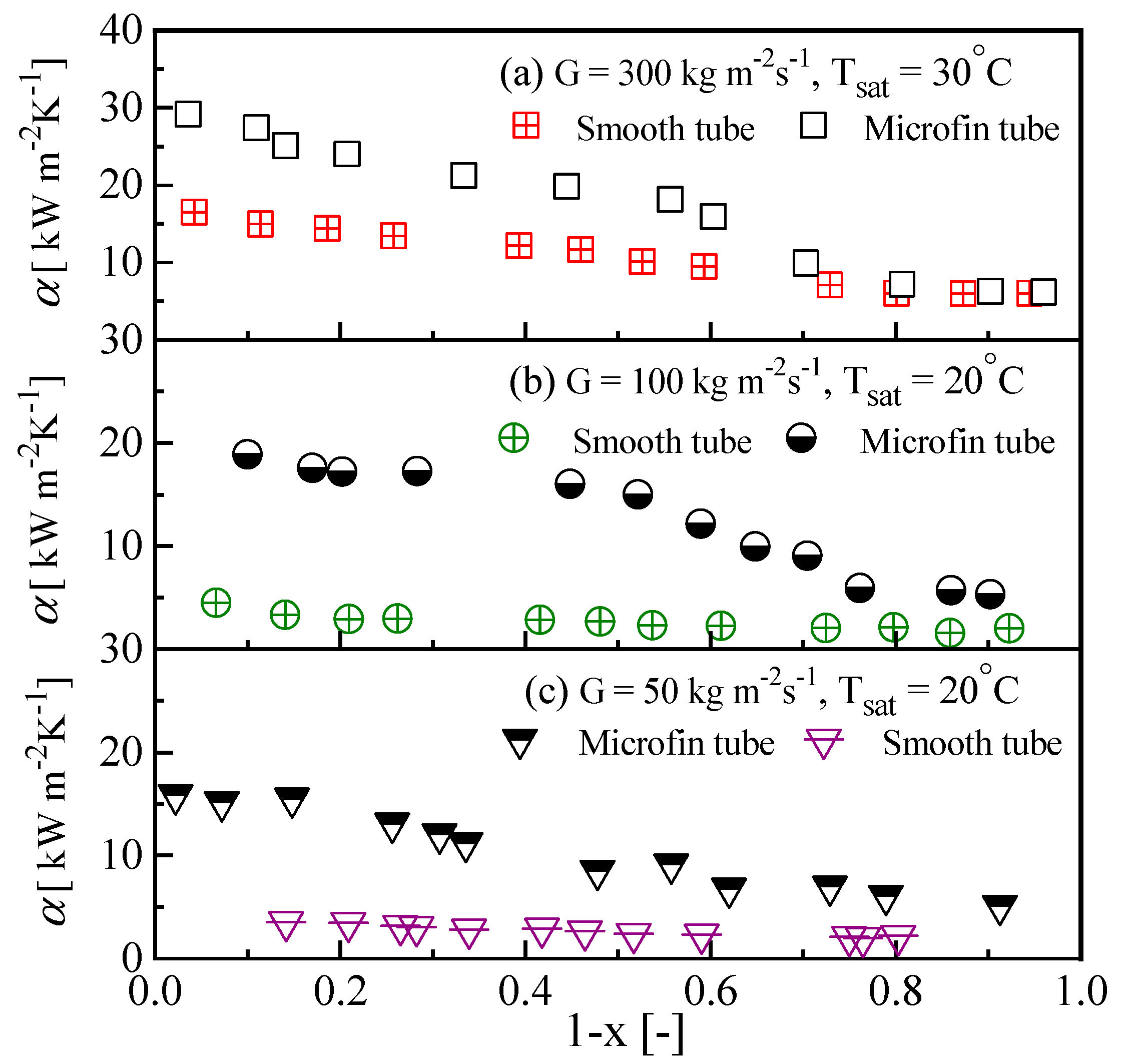
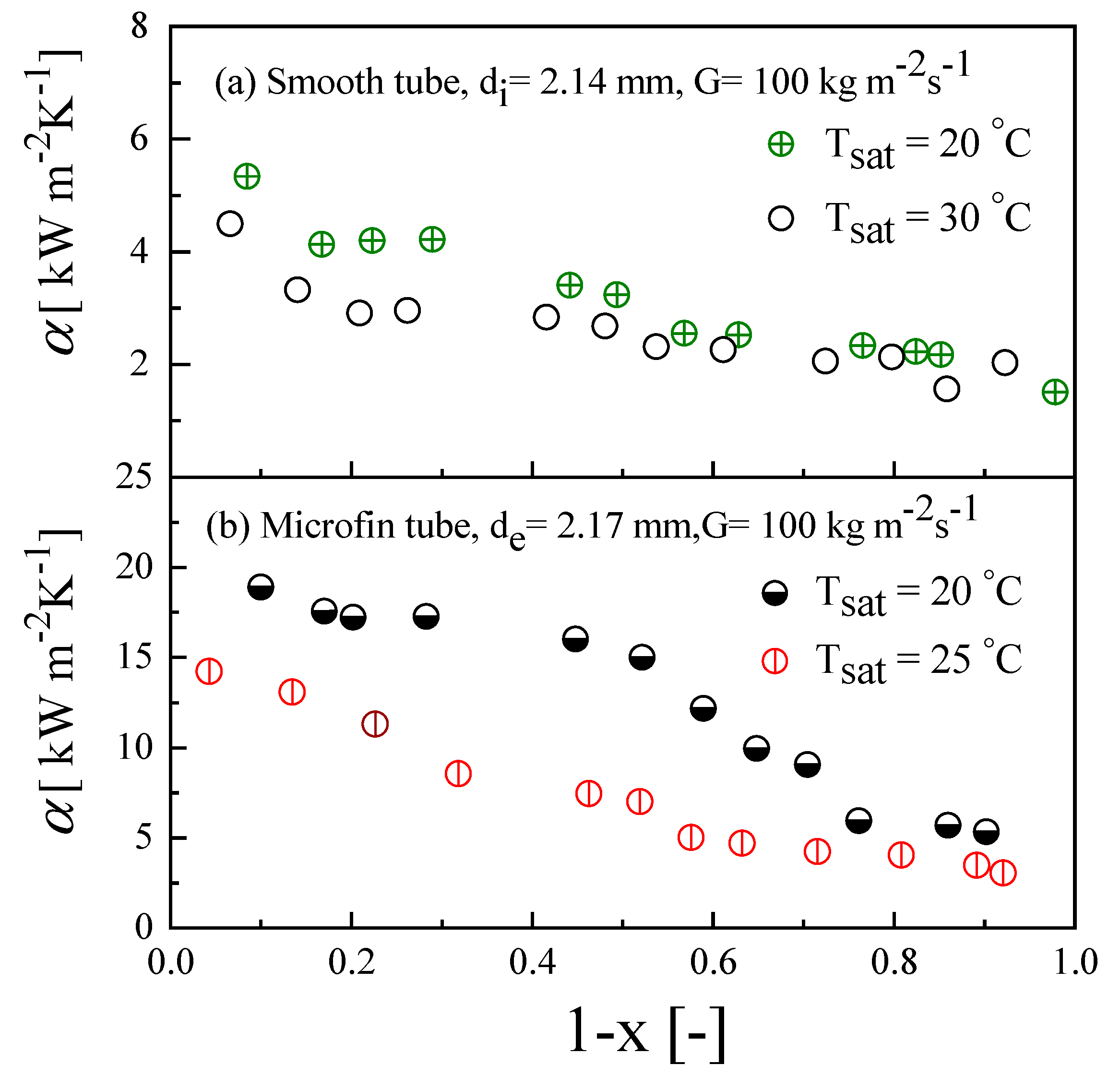
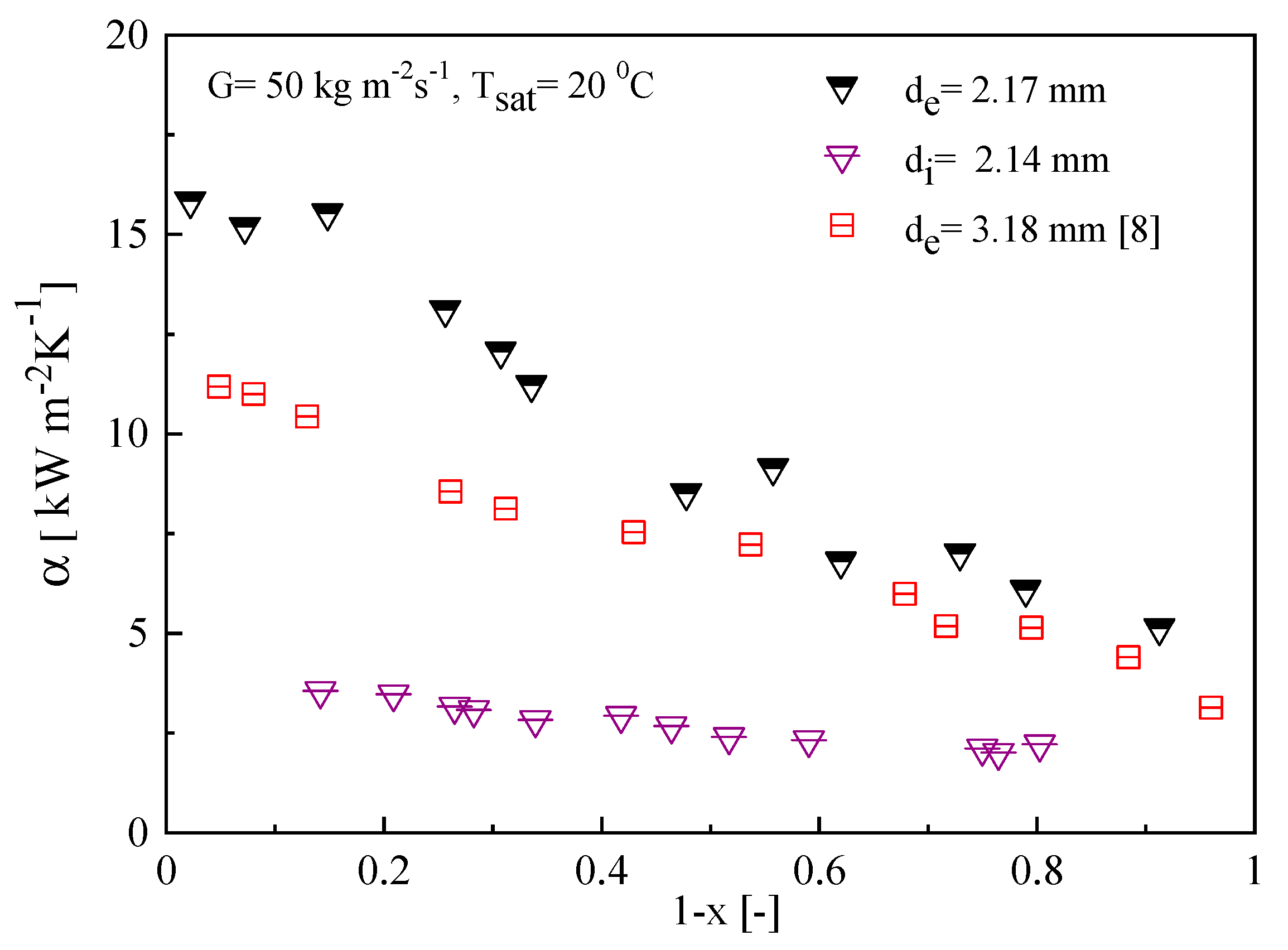
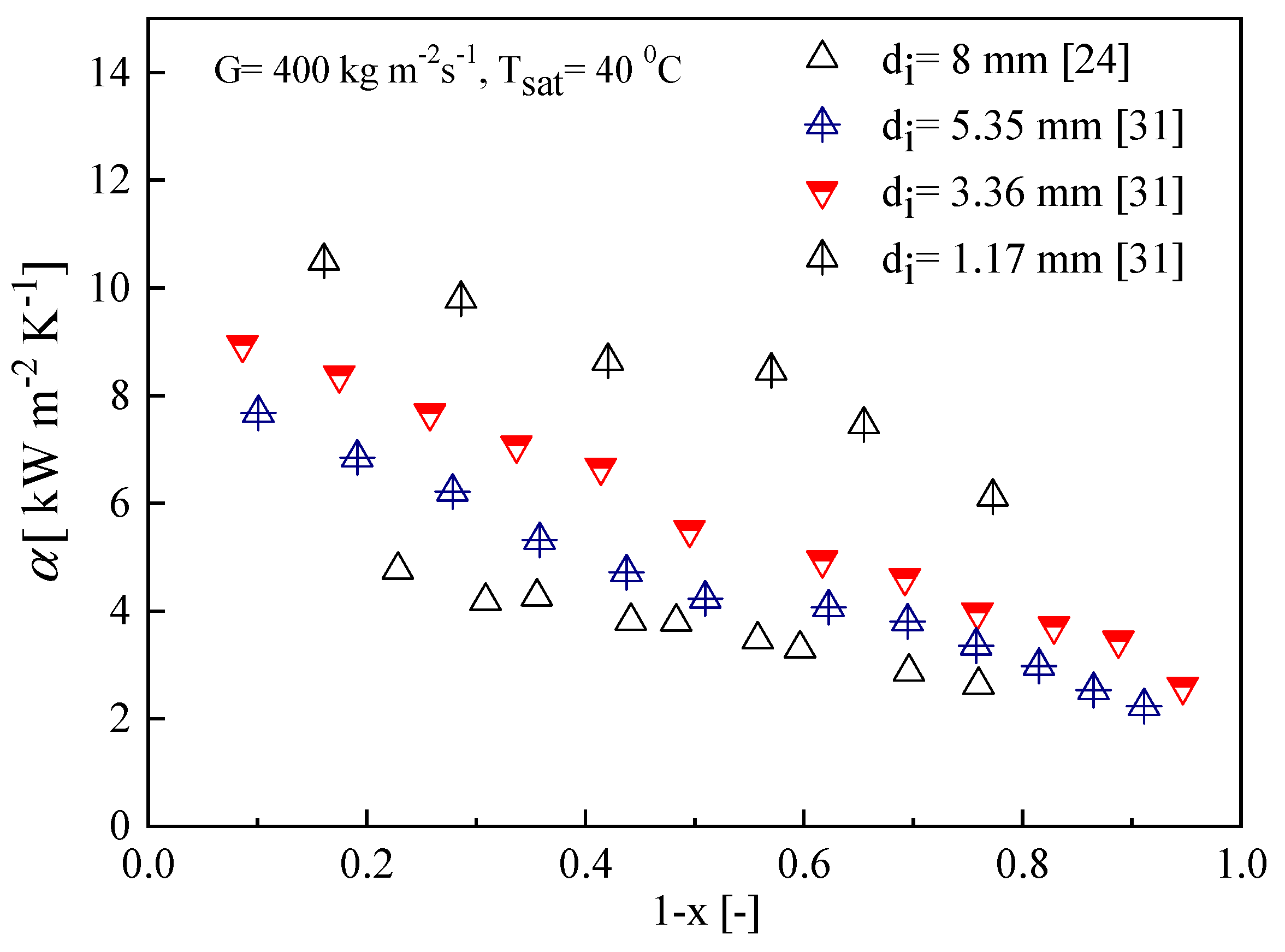
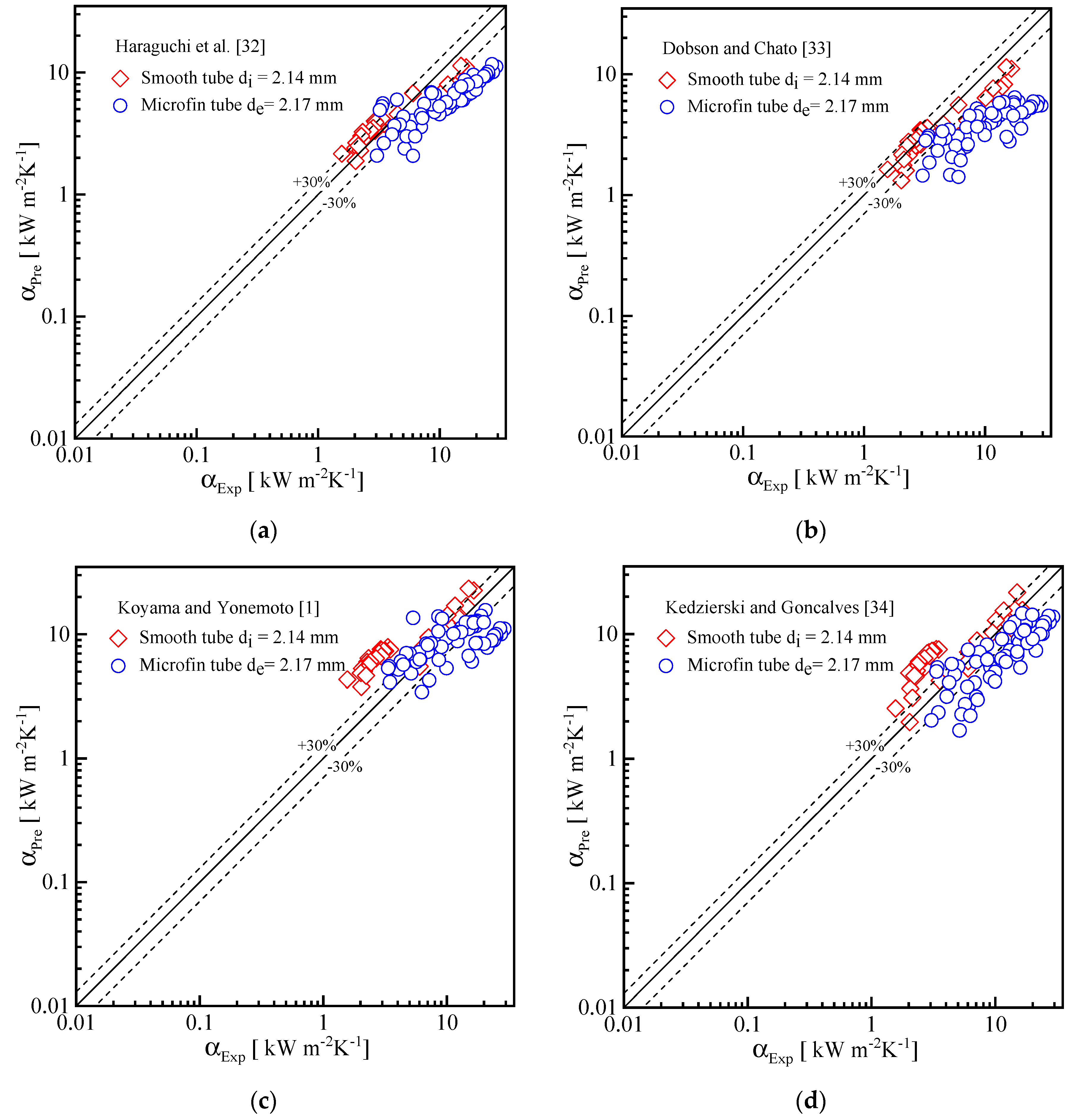
| Parameter [Unit] | Smooth Tube | Microfin Tube |
|---|---|---|
| Outside diameter do [mm] | 2.5 | 2.5 |
| Inner diameter di [mm] | 2.14 | - |
| Equivalent diameter de [mm] | - | 2.17 |
| Wall thickness δ [mm] | 0.18 | 0.15 |
| Fin height h [mm] | - | 0.10 |
| Apex angle γ [°] | - | 31 |
| Helix angle θ [°] | 10 | |
| Number of fin n [-] | - | 25 |
| Tsat [°C] | ρl [kg m−3] | ρv [kg m−3] | µl [µPa-s] | µv [µPa-s] | σ [mN m−1] | ||
|---|---|---|---|---|---|---|---|
| 20 | 1225.90 | 27.65 | 44.34 | 207.75 | 11.48 | 18.09 | 8.71 |
| 25 | 1207.30 | 32.20 | 37.50 | 195.25 | 11.68 | 16.71 | 8.05 |
| 30 | 1188.00 | 37.37 | 31.79 | 183.47 | 11.90 | 15.41 | 7.40 |
| Author(s) | Correlation | Experimental Condition |
|---|---|---|
| Miyara et al. [2] | do = 7 mm, smooth, helical and herringbone microfin tube. Fluid: R410A, R22 G: 100–400 kg m−2s−1. | |
| Muller and Heck [25] | d = 4–392 mm Fluid: air–water, air–oil, hydrocarbon, R11, R12, R22 G: 50–2490 kg m−2s−1. | |
| Haraguchi et al. [26] | di = 8.4 mm, smooth tube. Fluid: R134a, R123, R22 G: 99.8–402 kg m−2s−1. | |
| Olivier et al. [27] | do = 9.51–9.55 mm, circular smooth, helical and herringbone tube. Fluid: R22, R407C, R134a G: 400–800 kg m−2s−1. |
| Correlation | Smooth Tube | Microfin Tube | All Data | |||
|---|---|---|---|---|---|---|
| AD (%) | MD (%) | AD (%) | MD (%) | AD (%) | MD (%) | |
| Miyara et al. [2] | −26.29 | 26.33 | −32.83 | 44.79 | −30.88 | 35.24 |
| Muller and Heck [18] | 11.64 | 22.93 | 7.50 | 40.88 | 7.05 | 30.03 |
| Haraguchi et al. [19] | 5.98 | 27.33 | −7.76 | 36.80 | 0.48 | 31.06 |
| Olivier et al. [20] | −26.72 | 33.29 | −41.95 | 46.75 | −34.11 | 40.89 |
| Author(s) | Correlation | Experimental Condition |
|---|---|---|
| Haraguchi et al. [32] | , | d = 8 mm, smooth tube. Fluid: R134a, R22, R123 G: 90–400 kg m−2s−1. |
| Dobson and Chato [33] | d = 3.14–7.04 mm, smooth tube. Fluid: R134a, R12, R22, mixture (R32/R125), G: 25–800 kg m−2s−1. | |
| Koyama and Yonemoto [1] | , | do = 7.52 mm, microfin tube. Fluid: R134a, R123, R22 G: 200–500 kg m−2s−1. |
| Kedzierski and Goncalves [34] | d = 3.14–7.04 mm, microfin tube. Fluid: R134a, R124, R32, R410A, mixture (R32/R125) G: 57–552 kg m−2s−1. |
| Correlation | Smooth Tube | Microfin Tube | All Data | |||
|---|---|---|---|---|---|---|
| AD (%) | MD (%) | AD (%) | MD (%) | AD (%) | MD (%) | |
| Haraguchi et al. [32] | 2.15 | 31.10 | −40.74 | 98.14 | −24.48 | 73.56 |
| Dobson and Chato [33] | −15.36 | 20.69 | −60.16 | 60.16 | −43.36 | 45.36 |
| Koyama and Yonemoto [1] | 99.57 | 99.68 | −12.47 | 35.87 | 27.97 | 59.19 |
| Kedzierski and Goncalves [34] | 75.48 | 77.62 | −34.42 | 40.10 | 6.06 | 53.92 |
© 2018 by the authors. Licensee MDPI, Basel, Switzerland. This article is an open access article distributed under the terms and conditions of the Creative Commons Attribution (CC BY) license (http://creativecommons.org/licenses/by/4.0/).
Share and Cite
Bashar, M.K.; Nakamura, K.; Kariya, K.; Miyara, A. Experimental Study of Condensation Heat Transfer and Pressure Drop inside a Small Diameter Microfin and Smooth Tube at Low Mass Flux Condition. Appl. Sci. 2018, 8, 2146. https://doi.org/10.3390/app8112146
Bashar MK, Nakamura K, Kariya K, Miyara A. Experimental Study of Condensation Heat Transfer and Pressure Drop inside a Small Diameter Microfin and Smooth Tube at Low Mass Flux Condition. Applied Sciences. 2018; 8(11):2146. https://doi.org/10.3390/app8112146
Chicago/Turabian StyleBashar, M. Khairul, Keisuke Nakamura, Keishi Kariya, and Akio Miyara. 2018. "Experimental Study of Condensation Heat Transfer and Pressure Drop inside a Small Diameter Microfin and Smooth Tube at Low Mass Flux Condition" Applied Sciences 8, no. 11: 2146. https://doi.org/10.3390/app8112146
APA StyleBashar, M. K., Nakamura, K., Kariya, K., & Miyara, A. (2018). Experimental Study of Condensation Heat Transfer and Pressure Drop inside a Small Diameter Microfin and Smooth Tube at Low Mass Flux Condition. Applied Sciences, 8(11), 2146. https://doi.org/10.3390/app8112146





